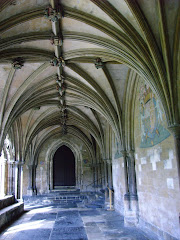In nearly every Episcopal church where I have served or been a member there has been a Mary altar in part of the nave. At my sponsoring parish in Lexington, the priest had brought back from Central America a wonderful statue of Mary holding the Christ child. Here at Holy Trinity, our Mary altar includes a three-part picture, called a triptych, and we also have an icon showing the same scene—Mary holding the baby. In each case Mary is dressed in traditional blue and flanked by angels on either side.
At evening prayer, the traditional canticle is the song of Mary, which we said and sang last week. The monks of Gethsemane in Kentucky every day sing the Canticle of Mary, and say a rosary after their final prayers of the evening. Anglo-Catholic groups of Anglicans practice Marian devotions than more protestant groups. But most of us Episcopalians see Mary as worthy of attention, whether we light a candle here at our Mary altar or think about her as the bearer of God.
Roman Catholics and Anglicans all agree that Mary is not divine, but is a servant of the divine, bringing God into the world. We do not worship her but put her in a category with the saints, a little above those we remember, as a figure who is central to our faith. She is at once filled with grace and favored by God, but also the specific person God chose to announce the coming of God’s son into the world.
Mary heard the words of the angel Gabriel with mixed emotions, which makes her a figure we can relate to—she is first perplexed, an understandable reaction, wondering what is going on with a greeting from an angel of God. She must also have been afraid for the angel tells her not to fear. When the angel tells her she is going to bear a son, she is very surprised for she is a virgin, and asks how can this be. Nothing is impossible with God, the angel answers her. At that message, Mary seems to realize that God is truly with her, and she acquiesces to this amazing and frightful news by replying “here am I” to all that has transpired.
So, a peasant girl of perhaps twelve or thirteen years old, the age of betrothal at this time, becomes the bearer of God. How are we to react? What does this mean to you?
In a book he wrote about praying with the icons of Mary, Rowan Williams, the Archbishop of Canterbury said: "It is not only that we cannot understand Mary without seeing her as pointing to Christ; we cannot understand Christ without seeing his attention to Mary".
The peasant girl who will be the mother of Christ points to a baby, born among the animals of the manger, visited by peasant sheepherders. She points to Christ who will serve the humble, the captives, the least of those among us, showing that in their lowliness God is with them. Christ tasted their wine, ate their bread, and knew their homelessness.
Mary makes real the entrance of God into the world at a very particular point in time, to a very specific young woman, bethrothed to a specific man of Nazareth. This is not a message about God forcing God’s will upon a human being, but God announcing God’s favor to a lowly girl, who in turn feels many things, and finally sees that God is about to do something new in her. Mary becomes the willing servant of God, offering her very self. This offering of her body points to the offering that Christ will make of his body. They both, mother and son, serve God specifically by embodying the love of God for all humanity. So Mary points to servanthood and self-giving in the great dream of God to bring all humans to God’s heart in love.
Mary points to the miracle of this love—that it came as through a lowly girl in first century Palestine, and lived in a humble traveling prophet who worked miracles with the sick, ate with outcasts and sinners, and ultimately was reunited with us through resurrection. Mary points to these miracles, that with God nothing is impossible.
Fear not, the angel says, for God with you. Emmanuel, in Hebrew. Mary points to the opening of her heart by overcoming her fear and perplexedness, overcoming her doubts about the bearing of a son though God’s spirit. She does not deny her fear and confusion, but keeps listening to the message God has for her, stays with the feelings and then becomes a partner with God in this miracle of love.
What does Mary point to for you? Do you find your own feelings in this message from Gabriel? Advent has many seeking a miracle and here we find it. Advent has us waiting with Mary for this son, whose birth we will celebrate in a week. The message of this last few days before the Christ Mass is that God favored a peasant girl, and she stepped through her swirl of emotions to accept God’s favor, in a willing giving of herself to bring God’s incarnate love into the world. In these last days of Advent, be ready for this love.


No comments:
Post a Comment